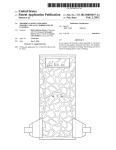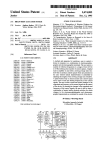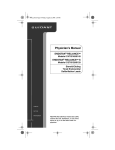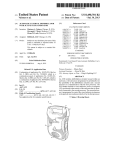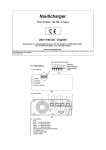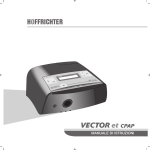Download rzoj 122/ 124}
Transcript
US006223077B1 (12) United States Patent (10) Patent N0.: Schweizer et al. US 6,223,077 B1 (45) Date of Patent: (54) AUTOMATIC POWER SWITCHING IN A DEFIBRILLATOR Apr. 24, 2001 Primary Examiner—George R. Evanlsko (74) Attorney, Agent, or Firm—Christensen O’Connor Johnson Kindness PLLC (75) Inventors: Scott 0. Schweizer, Snohomish; Gus H. White, Redmond; Aaron Huynh, (57) Bothell, all of WA US ABSTRACT ( ) (73) Assignee: Physio-Control Manufacturing Corporation, Redmond, WA (Us) A method and apparatus for providing automatic power switching in a portable external de?brillator is disclosed. The power supply switching circuit includes a plurality of ( ) power supply ports for receiving power sources such as batteries and external power sources. The power supply Nonce' Subject to any dlsclalmer’ the term of thls patent is extended or adjusted under 35 USC' 154 b b 0 d ( ) y ' switching circuit works with both batteries that include ays monitoring devices (smart batteries) and batteries that do not (21) App1_NO_,09/013,142 include monitoring devices (dumb batteries). The power (22) Filed: supply switching circuit also includes microprocessor con trollable switches for selectively coupling the power supply (51) (52) (58) Jah- 26’ 1998 Int. c1.7 ..................................................... .. A61N 1/39 US. Cl. ................................................. .. 607/5; 607/29 Field of Search ................................. .. 601/5, 6, 29, 9 (56) ports to the Output of the power supply Switching Circuit, and a microprocessor ror oohrrohrhg the Switches and for rhohr' torrhg the power Supply ports‘ Resident in the rhrcroproces' sor is a control program for controlling the switching and References Cited monitoring operations. The control program uses data Us PATENT DOCUMENTS received from the power sources to select the best available power source to be used as the output for the power supply switching circuit. The control program has routines for 473237075 4/ 1982 Lang“ - 5,063,928 11/1991 Grevis et al. . monitoring both smart and dumb batteries, and the power iiirlrllgrztz :1? iil' ' 516113315 supply switching circuit can thus use a combination of smart 3/1997 Cole et a1_ _ 5,674,252 5,690,685 and dumb batteries. In one test, a load is placed on a battery 10/1997 Morgan et a1_ _ 11/1997 Kroll et a1_ _ 5,868,794 * and then the output voltage of the battery is measured. Auser of the de?brillator is kept completely informed as to the 2/1999 Barkley etal. ...................... .. 607/29 status of the power sources through information that is OTHER PUBLICATIONS provided from a display or auditory signals. For smart _ Selected Pages from LIFEPAK 11 De?brlllator/Pacemaker Service Manual, Jan. 1995. batteries, a fuel gauge is provided on the display. Warnings are provided when a battery needs changing, or when other user action is required, Linear Technology LTC 1479 Data Sheet, 1996. * cited by examiner 30 Claims, 6 Drawing Sheets 150 -?_> COMMON SYSTEM POWER S10 BATTERY 20 126i, SERIAL COM 5 40 WT I08 7 m I 1a MIL/EFL 12 [16 BATTERY "2 22 SERIAL 30 g110 r MICROPROCESSOR COM AND sIIITcII CONTROL 106 814 I “\l CHARGE [ EXTERNAL 28 (114 34 44 SUPPLY SERIAL COM 134 24 / / rzoj 122/ 124} 128 SERIAL COM <>_—- g” MONITOR 126) 26 SERIAL coAII 8Y5?” U.S. Patent Apr. 24, 2001 Sheet 2 0f 6 USER PRESSES SWITCH US 6,223,077 B1 220 FROM OFF POSITION PROVIDE SELECTED 200 ‘ SOURCE INFORMATION Y 4 T0 USER AUXILIARY SUPPLY ATTACHED ANB OPERATINC WITHIN YEs SELECT AUXILIARY ACCEPTABLE PARAMETERS , SUPPLY ? N0 202 VALID BATTERY POWER 204 BAT. 10 LON AND YES SOURCE ABOYE RESERVE 214 YES BAT. 12 NOT LOW LEVEL 0. g2 NO 206 N0 208 BA T. 12 HAS LOWER CHARGE AUTOMATICALLY TURN YES LELQEL OFF DEVICE N0 210 218 BATTERY 10 YES FAULT 216 NO SELECT BATTERY 10 [150.2 SELECT BATTERY 12 ' U.S. Patent Apr. 24, 2001 SMART BATTERY US 6,223,077 B1 Sheet 3 0f 6 NO COMMUNICATION RECEIVED '2 220 SMART BATTERY COMMUNICATE ZERO CAPACITY AND FAULT YES INDICATION OPERATE AS THOUGH COMMUNICATION WITH SMART BATTERY HAS BEEN LOST BUT PERIODICALLY RECHECK TO SEE IF COMMUNICATION HAS BEEN RES TORED 3 224 SMART BATTERY GIVE INDICATION OF LOW BATTERY COND‘IPTION NO YES LOW BATTERY CONDITION DETECTED 3 228 U.S. Patent Apr. 24, 2001 Sheet 4 0f 6 US 6,223,077 B1 NON-SMART BATTERY IS BEING MONITORED ( OR 230 SMART BATTERY WITH NO COMMUNICATION) 234 AFTER UNIT IS FIRST POWERED ON AND LOAD TEST IS RUN, IS BATTERY VOLTAGE GREATER THAN OR EQUAL TO 10.5V AFTER ZOOMS N0 WITHIN 2 SECONDS LOW BATTERY DETECTED AND ——>@ DISPLAYED TD USER k 238 I NORMAL OPERATION, IS SENSED BATTERY VOLTAGE LESS THAN END OF BATTERY _>® RESERVE DETECTED OR EQUAL TO 8.28V FOR 1 SAMPLE '2 IS SENSED BATTERY VOLTAGE LESS THAN OR EQUAL TO 10.5V + 0'!" — FOR 1 SECOND ? YES 5% U.S. Patent 250 Apr. 24, 2001 Sheet 5 0f 6 US 6,223,077 B1 S) LOW BATTERY INDICATOR m IS ACTIVATED IS DEFIBRILLA TOR TURNED OFF ? 252 N0 YES 1s POWER REMOVED FROM DEFIBRILLA TOR YES ‘E’ 254 NO LOW BATTERY VOLTAGE CAUSED YES DEFIBRILLATOR TO TURN OFF 256 NO HAS BATTERY BEEN REMOVED YES 9 258 262 N0 V DEFIBRILLATOR YES COUPLED TO AC POWER OR AC POWER THROUGH AN I DEACTIVATE LOW BATTERY INDICATOR AUXILIARY POWER SUPPLY 260 [15,21 U.S. Patent SMART BATTERY ? Apr. 24, 2001 Sheet 6 0f 6 NO \ M f K 2 78 COMM UNICA TION PROBLEM ? 2 72 US 6,223,077 B1 286 PROVIDE ALERT TONE AND INDICATE DISPLAY ”CHECK BATTERY" DUMB BATTERY NO INDICATE DUMB LOW BATTERY 288 280 DISPLAY "REPLACE BATTERY”ANO AN ALERT YES INTERNAL FAULT TONE FOLLOWED BY A REPEATED PRIORITY 3 TONE 282 2 LO W BA TTERY YES INDICATE SMART LO W BA TTER Y 292 DISPLA Y ‘ CHARGE LEVEL Fig.4 ALL BATTERIES LOW '2 N0 US 6,223,077 B1 1 2 AUTOMATIC POWER SWITCHING IN A DEFIBRILLATOR charge the capacitor that provides energy for the de?brilla tion pulse. While one solution to this problem Would be to provide sWitches for bypassing a dead battery, this solution is unacceptable because it drops the voltage of the series FIELD OF THE INVENTION batteries by removing the voltage provided by the “dead” This invention relates generally to methods and apparatus battery. Even a “dead” battery that is unable to deliver suf?cient current is usually capable of adding at least some voltage to the overall level of the series battery circuit. The for providing poWer to a cardiac de?brillator and, more speci?cally, to switching betWeen various available cardiac de?brillator poWer sources. BACKGROUND OF THE INVENTION 10 15 required to operate a ?brillation detection circuit. In Langer, the diodes D1 and D2 alloW the necessary current require ments for the charging circuit to be met by bypassing the current around a dead battery, While still alloWing the voltage level from the dead battery to be included in the circuit for operating the ?brillation detection circuit. Other implantable de?brillators have attempted to address the need to generally monitor the life of a de?brillator battery so that some Warning can be given before the battery is completely drained. Such a device is shoWn in US. Pat. 20 No. 5,292,348 to SaumareZ et al., Which discloses an Batteries are often used to poWer portable electronic de?brillators. Portable de?brillators generate and apply a high-energy de?brillation pulse to the chest of a patient to cause the patient’s heart to stop ?brillating and return to a normal rhythm. The pulses require high energy levels (up to 360 joules) and sometimes multiple de?brillation pulses are required to restore the patient’s heart to a normal rhythm. Thus, de?brillators require large amounts of poWer during normal use. Because of the poWer requirements, portable external de?brillators generally use special battery packs to poWer the de?brillator. If the batteries that are being used by the de?brillator become depleted, the patient cannot be treated. The poWer supply needs for portable de?brillators are distinct from many other portable devices in that the preci sion and urgency required is much greater, because a implantable cardioverter/de?brillator and method employ ing cross-phase spectrum analysis for arrhythmia detection, 25 applied quickly. Thus, it is important that a de?brillator be able to resolve any poWer supply problems quickly With a monitoring the battery’s condition. The signal line provides an end of battery life (EOL) signal to a microprocessor. The EOL signal is a logic signal Whose status is indicative of the 30 35 batteries. Such de?brillators alloW an operator to sWitch to describe a device and method for performing automatic battery maintenance as particularly applied to an implant sWitches to select one of the alternate poWer sources. Such able cardioverter de?brillator. Batteries are maintained at a 40 predetermined state of charge by addressing a problem 45 internal to the battery itself, speci?cally that over time batteries can develop a high internal impedance or equiva lent series resistance. As described, the voltage, current or other parameter from the battery is monitored to determine if the state of charge value is too loW, in Which case a battery battery maintenance With a gauge or other device. It is dif?cult in such systems for a user to keep track of Which poWer source is most appropriate for use and When to sWitch from one source to another Without affecting unit operation. One particular problem is that sWitching of the poWer Within a de?brillator. One such device is shoWn in US. Pat. No. 5,690,685 to Kroll et al., issued Nov. 25, 1997, Which discloses an automatic battery-maintaining implantable car dioverter de?brillator and method for use. Kroll et al. the backup batteries if the original batteries fail. In the past, such systems have usually required the user to manually set systems have also required the user to manually track the approach of battery failure in the poWer supply. Still other implantable de?brillators have addressed the issue of the need to perform automatic battery maintenance minimum of distraction to the user. Due to the critical nature of the poWer supply, some portable de?brillators have been equipped With backup and also in US. Pat. No. 5,063,928 to Grevis et al., Which discloses an apparatus and method for detecting and treating cardiac tachyarrhythmias. Both of these patents shoW a poWer supply, such as a battery, and a signal line for patient’s life is often at stake. Urgency is often required because the chances that a patient’s heart can be successfully de?brillated increase signi?cantly if a de?brillation pulse is voltage provided by the dead battery, in addition to the voltage provided by the good battery(s), are often both supply in a de?brillator can interrupt critical functions, such as monitoring of the patient’s heart and the charging of the loading maintenance cycle is sWitched into activation until the state of charge value improves. circuitry in preparation for applying a de?brillation pulse. Also, many de?brillators have special safety systems that supply issues that arise for de?brillators, they do not address While the above devices do address some of the poWer monitor for out-of-tolerance voltages in the system and the issues of hoW and When to sWitch to backup poWer supplies. Neither do they make use of the features of the neW “smart” batteries that have been developed to provide mea surements of their oWn internal parameters and thus indicate trigger a reset When out-of-tolerance voltages occur. Thus, poWer sWitching in such systems can accidentally trigger the safety reset of the system. Some prior implantable de?brillators have attempted to address some of the poWer supply issues of de?brillators. One such device is shoWn in US. Pat. No. 4,323,075 to Langer, Which discloses a method for battery failure com pensation for a poWer supply used in an implantable de?bril lator. As shoWn in FIG. 2 of Langer, a pair of batteries B1 and B2 are connected in series to provide the poWer for the de?brillator circuit. TWo diodes, D1 and D2, are connected When battery failure is approaching. Nor are they easily 55 upgradable to make use of neW battery technologies as they develop. The present invention is directed to providing a method and apparatus that overcome the foregoing and other disad vantages. More speci?cally, the present invention is directed 60 to providing a method and apparatus for automatic poWer sWitching in a portable de?brillator that makes use of the in parallel With each of the batteries B1 and B2, respectively. most recently available battery technologies and is easily As described, one of the problems With the circuit is that if one of the batteries connected in series goes “dead,” the current output by the series of batteries is limited by the output of the dead battery. This presents a serious problem upgradable. in a de?brillator Where a high current is often needed to 65 SUMMARY OF THE INVENTION In accordance With this invention, an automatic poWer sWitching method and apparatus is provided. The apparatus US 6,223,077 B1 3 4 comprises an automatic power switching circuit that includes power supply ports for receiving poWer sources able to determine When such tests are not need for certain smart batteries, Which may provide such data Without requir such as batteries and external poWer sources. The automatic ing the use of such tests. poWer sWitching circuit also includes microprocessor con In accordance With another aspect of the invention, the microprocessor uses a display and certain auditory tones to provide information to a user regarding the status of the trollable sWitches for selectively coupling the poWer supply ports to the output of the poWer supply. The automatic poWer sWitching circuit further includes a microprocessor coupled to the poWer supply ports and sWitches for monitoring the poWer sources and for selectively controlling the sWitches. In accordance With one aspect of the invention, the microprocessor is controlled by a control program. The poWer sources. Indications are provided When batteries are in need of maintenance or charging. In addition, a fuel gauge 10 sources according to criteria that are desired for the opera tion of a portable device such as an external de?brillator. Thus, a user is kept completely informed as to the status of control program includes a selection routine for selecting a poWer supply port receiving poWer from a poWer source to be coupled to the output of the poWer supply. The selection routine evaluates data received from the poWer sources, and evaluates the data according to criteria that are desired for the operation of an external de?brillator. The selection routine includes a subroutine suitable for evaluating data received from smart batteries. Thus, the user need not be concerned With What the poWer source is and When to sWitch, as the microprocessor takes care of these consider may be displayed on the display for smart batteries. Special routines are provided for testing and monitoring the poWer 15 the poWer sources, and is prompted if action is needed. This is extremely advantageous in a de?brillator, Where inatten tiveness or lack of information regarding poWer supply problems can possibly render a de?brillator inoperable. In accordance With another aspect of the invention, all of the poWer sources are sWitched and fused to a single common system poWer output. This requires feWer unit ations. Using the control program, the microprocessor is also Wires carrying large currents. Also, the electronic sWitching able to perform selection of a poWer source Within a pre and the use of solid-state sWitches avoids the electrome chanical failures of manual sWitches that Were used in determined time frame and With a level of precision that alloWs smooth and uninterrupted operation of the de?bril 25 lator. In accordance With another aspect of the invention, the selection routine also includes a subroutine suitable for evaluating data received from non-smart or dumb batteries. This alloWs the poWer supply sWitching circuit to make use of both smart and non-smart batteries Within a single device. previous devices. BRIEF DESCRIPTION OF THE DRAWINGS The foregoing aspects and many of the attendant advan tages of this invention Will become more readily appreciated as the same becomes better understood by reference to the This is especially advantageous in de?brillators, Where folloWing detailed description, When taken in conjunction With the accompanying draWings, Wherein: special battery packs are often used, and the expense or non-availability of certain types of battery packs may make FIG. 1 is a block diagram of an automatic poWer sWitch ing circuit for use in a portable de?brillator according to the combined usage a requirement. 35 In accordance With another aspect of the invention, the control program detects When an external supply is FIG. 2 is a How chart illustrating the poWer supply selection method of the present invention; FIG. 3 is a How chart illustrating a battery monitoring available, and can use the external supply to poWer the de?brillator. The microprocessor also coordinates the charg ing of the batteries With the use of the external supply. Also, method for a smart battery; FIG. 4 is a How chart illustrating a battery monitoring the selection routine of the control program includes a subroutine suitable for evaluating data received from a smart method for a non-smart battery; FIG. 5 is a How chart illustrating a loW battery indicator external poWer supply. Thus, a portable external de?brillator can be plugged or unplugged from an external poWer supply, and batteries can be used and replaced, With automatic poWer sWitching taking place so as to not affect or interrupt present invention; activation and deactivation method; and 45 FIG. 6 is a How chart illustrating a method for generally displaying information to a user of the device. critical de?brillator operations. This is especially important DETAILED DESCRIPTION OF THE PREFERRED EMBODIMENT in de?brillators, Where rapid selection and use of the best available poWer source is critical, and Where improper sWitching betWeen poWer supplies may cause interruption of The present invention is a method and apparatus for critical de?brillator operations. One particular type of criti cal interruption that may be avoided is the safety reset providing automatic selection and sWitching betWeen vari interruption that occurs When out of tolerance voltages are de?brillator that provides a de?brillation pulse to a patient’s heart. Portable de?brillators may be poWered by tWo or more ous available poWer sources, and in particular batteries in a caused by improper poWer sWitching and thus cause the system to reset. The safety reset can cause capacitor charg 55 ing and patient monitoring system reinitialiZation delays that are also thus avoided. In accordance With another aspect of the invention, one of the tests for the batteries in the de?brillator consists of placing a load on them and attempting to draW a relatively patient both quickly and With enough energy. OtherWise the patient may be harmed. Ablock diagram of an automatic poWer sWitching circuit formed in accordance With the present invention is illus high current (eg 1 amp). The output voltage of the battery is then also measured a short time later (eg after 200 milliseconds) to determine if it falls Within a speci?ed range (e.g. above 10.5 volts for a 12 volt battery). This type of test is especially important in de?brillators, Where high currents and consistent voltage levels are needed for consistent and reliable de?brillator operation. The microprocessor is also batteries or by an external poWer source, When available. Rapid selection of the best available poWer source for a de?brillator With a minimum of distraction to a user is highly desirable because a de?brillation pulse must be applied to a 65 trated in FIG. 1. The circuit includes tWo batteries 10 and 12, an external poWer supply 14, and a microprocessor and sWitch controller 16. As Will be described more fully beloW, the microprocessor and sWitch controller 16 monitors the condition of the batteries 10 and 12, and the external supply US 6,223,077 B1 5 6 14, and uses the resulting data to select one of the power decision block 202, the input poWer sources are sampled and supplies as the power supply for the system. The external poWer supply 14 may not always be available. The nature of the external poWer supply 14 depends on the type of de?brillator being used. In a type of de?brillator Which runs evaluated for acceptable operating parameters. Speci?cally, the microprocessor and sWitch controller 16 checks to determine if an external (auxiliary) supply is attached and is operating Within acceptable parameters. With reference to the circuitry of FIG. 1, this step is accomplished by the microprocessor and sWitch controller 16 checking lines 124 primarily off of DC battery poWer, the external poWer supply may be an external auxiliary supply that provides DC poWer but is itself poWered by AC. In another type of de?brillator that runs primarily off of AC poWer With battery backup poWer, the external poWer supply may be a source such as a Wall socket that provides AC poWer. Batteries 10 and 12 each have serial communication ports 20 and 22, respectively. External poWer supply 14 has a serial communication port 24. External poWer supply 14 is a “smart” external auxiliary supply that includes monitoring circuitry to perform measurements regarding the auxiliary supply’s condition (e.g., voltage and current output and 126 to determine if an external supply 14 is available. 10 is being carried around, so that batteries 10 and 12 are the only poWer supplies available. Returning to FIG. 2, if at decision block 202 the micro processor 16 determines that an external (auxiliary) supply 15 is available and is operating Within acceptable parameters, the microprocessor proceeds to a block 204. At block 204, the microprocessor selects the external (auxiliary) supply as the de?brillator poWer supply. Thus, if an auxiliary supply is capacities), and to make the results of the measurements available to the microprocessor through its serial commu nication port. Batteries 10 and 12 are “smart batteries,” i.e., batteries 10 and 12 are batteries that include monitoring circuitry to perform internal measurements as to the bat attached and is operating Within acceptable parameters, it takes precedence over the other poWer sources and is selected to poWer the de?brillator. With reference to the circuitry of FIG. 1, the operation at block 204 is performed by the microprocessor and sWitch controller 16 closing tery’s condition (e. g., the battery’s charge capacity, the level of stored energy, etc.) and make the results of the measure ments available to the microprocessor through their serial Although FIG. 1 is shoWn With external supply 14 included, it may often be disconnected When the portable de?brillator 25 communication ports. These measurements are sometimes referred to as providing a type of “smart fuel gauge” for the batteries. While batteries 10 and 12 are smart batteries, as sWitch 44 such that the output 114 from external poWer supply 14 is connected to the common system poWer line 150. Returning to FIG. 2, if at decision block 202 the micro processor determines that no external (auxiliary) supply is Will be described beloW, the system is also designed to attached or, if attached, is not functioning properly, the obtain and process information from older non-smart or microprocessor proceeds to a decision block 206. At deci “dumb” batteries. The serial communication ports 20, 22, sion block 206, the microprocessor monitors the available and 24 are coupled through a bus line 126 to a serial batteries to determine Which batteries have poWer and their status (as Will be described in more detail beloW With communication port 26 of the microprocessor and sWitch controller 16. Thus, microprocessor and sWitch controller 16 is able to monitor the condition of batteries 10 and 12 and external poWer supply 14 through the information provided from the serial communication ports 20, 22, and 24, respec tively. Microprocessor and sWitch controller 16 also 35 includes a serial communication output port 28 for providing data to the general de?brillator control circuit and display reserve levels While under a load. While performing this evaluation, the microprocessor and sWitch controller 16 (not shoWn) through a line 128. The poWer outputs for batteries 10 and 12 are coupled to lines 110 and 112, respectively. The poWer output for external supply 14 is coupled to a line 114. External poWer supply 14 also includes a port 6 for providing a charging reference to FIGS. 3—6). With reference to the circuitry of FIG. 1, the operation at block 206 corresponds to the microprocessor evaluating batteries 10 and 12 for proper operating parameters. These operating parameters are based on the battery’s ability to maintain voltage above minimum 45 output on a line 106 for charging the batteries 10 and 12. monitors serial communications from serial communication ports 20 and 22 and/or monitors outputs 110 and 112 to determine if the batteries 10 and 12 meet the operating parameters. If the smart batteries 10 and 12 are replaced by non-smart batteries, the determination of the batteries’ func tionality is based on the measurements of the outputs 110 Microprocessor and sWitch controller 16 monitors the volt age on lines 110, 112, and 114 through lines 120, 122, and 124, respectively, connected to a monitor port 17. Thus, in operating parameter requirements, the microprocessor pro the case Where non-smart batteries are used in place of smart softWare of the microprocessor automatically shuts off the batteries 10 and 12, voltage measurements can still be taken poWer to the de?brillator. and 112. If there are no poWer sources available that meet the ceeds to a block 218. At block 218, the poWer management by the microprocessor and sWitch controller 16 from the At block 206, if the microprocessor determines that at poWer outputs of the batteries on lines 110 and 112. Output lines 110, 112, and 114 are coupled to lines 130, 132, and 134 through uses 30, 32, and 34, respectively. The outputs from the poWer sources are fused for ?re safety. The lines 130, 132, and 134 are coupled through sWitches 40, 42, and 44, respectively, to a single common system poWer line 150. Preferably, the sWitches are solid state sWitches. SWitches 40, 42, and 44 are controlled by control lines 140, 142, and 144, respectively, from a selection port 18 in microprocessor and sWitch controller 16, Microprocessor and sWitch controller 16 also includes an on/off sWitch 8 that is controlled by a line 108 from the de?brillator system. FIG. 2 illustrates the poWer source selection operation of the automatic poWer sWitching circuit of FIG. 1. As shoWn at a block 200, the unit is ?rst turned on by a user. At a least one of the battery poWer sources meets the proper 55 operating parameters, the microprocessor proceeds to a decision block 208. The series of steps represented by blocks 208, 210, 212, 214, and 216 and described next comprise a routine run by the microprocessor that results in the selec tion of one of tWo batteries for use as the poWer source of the de?brillator. It Will be understood that in a system that contains more than tWo batteries, similar testing techniques can be used to select the most appropriate battery. At decision block 208, the microprocessor determines Whether the poWer condition of the battery 10 is loW and Whether the poWer condition of the battery 12 is above loW. 65 For non-smart batteries in a 12-volt system, a loW poWer condition is determined by measuring the output 110 or 112 of the battery to determine if it falls beloW a selected US 6,223,077 B1 7 8 threshold (e.g., 10.5 volts). When smart batteries are being used, the loW power condition is determined by monitoring With regard to selecting a poWer source and charging the batteries. The selected battery is fully used until a de?ned sWitching point is reached. When this occurs, the next the serial communication from ports 20 and 22 on line 126. From decision block 208, if battery 10 has a loW poWer condition While battery 12 does not have a loW poWer condition, the microprocessor proceeds to a block 214. At block 214, the microprocessor and sWitch controller 16 selects battery 12 to supply poWer to the de?brillator. With reference to the circuitry of FIG. 1, the selection of battery 12 at block 214 corresponds to the microprocessor and sWitch controller 16 closing sWitch 42 and thus connecting battery is selected. This alloWs complete use of battery poWer before sWitching, increasing unit operation time and battery life. As Will be described in more detail beloW, all sWitching is automatic and is made knoWn to the user through the system/user interface provided on the display 10 the output 112 to the common system poWerline 150. If at decision block 208 the microprocessor determines that the poWer condition of battery 12 is loW or that the poWer condition of battery 10 is not loW, the microprocessor device. The above-described functions of the automatic poWer sWitching system of the present invention are described in more detail beloW With reference to FIGS. 3—6. FIGS. 3—5 generally illustrate the internal measurements and determi 15 nations made by the microprocessor and sWitch controller 16, While FIG. 6 generally illustrates the procedures for proceeds to a decision block 210. At decision block 210, the displaying information to a user of the device. microprocessor determines if battery 12 has a loWer charge level than battery 10. In the preferred embodiment, the status of the charge level is easily read from smart batteries, as this is one of the internal measurements they provide. The microprocessor Will select the battery With the loWer charge As illustrated in FIG. 3, battery monitoring, such as that required at block 206 of FIG. 2, begins at point A of FIG. 3. At a decision block 220, the microprocessor 16 determines Whether smart battery communication is being received from a battery that is currently being monitored. If smart level to be used ?rst. This is done so that the most depleted battery communication is not being received, the micropro battery Will be used ?rst, thus alloWing for the most ef?cient cessor proceeds to a point B, Which Will be described in more detail beloW With reference to FIG. 4, and if smart use of the batteries in the system. If at block 210 the microprocessor determines that the battery 12 has a loWer 25 charge level than battery 10, the microprocessor proceeds to battery communication is being received, the microproces sor proceeds to a decision block 222. block 214 Where battery 12 is selected to poWer the system. If at block 210 the microprocessor determines that the battery 12 does not have a loWer charge level than battery 10, the microprocessor proceeds to a decision block 212. At Whether the smart battery has communicated a Zero capacity decision block 212, the microprocessor determines Whether such a communication has not been received, the micropro battery IO has a fault. A fault condition is communicated by a smart battery When the smart battery monitoring circuitry determines that the smart battery has an internal fault. Alternatively, a fault can be generated from any type of battery if the path to the battery, such as the fuse or the sWitch, goes bad or if the battery is unable to support a charge When tested. An example of a battery unable to cessor proceeds to a decision block 226. At decision block 222, the microprocessor determines or fault indication. If such a communication has been received, the microprocessor proceeds to a block 224, and if At block 224, the microprocessor is set to operate as 35 but sets a ?ag to periodically recheck to see if communica tion from the smart battery has been restored. From block 224, the microprocessor proceeds to point B, Which Will be described in more detail beloW With reference to FIG. 4. support a charge Would be 12-volt battery that consistently At decision block 226, the microprocessor determines drops to a 5-volt level When a load is placed on it. If battery 10 has a fault, then the microprocessor proceeds to block 214 Where battery 12 is selected to poWer the de?brillator. If at block 212 the microprocessor determines that battery 10 does not have a fault, the microprocessor selects battery 10 though communication With the smart battery has been lost, Whether the communication received from the smart battery gives an indication of a loW battery condition. If a loW battery condition is indicated, the microprocessor proceeds to a block 228, and if a loW battery condition is not indicated, provides selected source information to a user on a display the microprocessor returns to decision block 220 and battery monitoring is continued. At block 228, if a loW battery condition is detected, the microprocessor indicates to the user that a loW battery condition has been detected and, then, proceeds to a point C, Which Will be described in more detail device, Which the microprocessor communicates With via beloW With reference to FIG. 5. to poWer the de?brillator. 45 From blocks 204, 214, and 216, the microprocessor proceeds to a block 220. At block 220, the microprocessor port 28 and communication line 128. The information about FIG. 4 illustrates the continuing battery monitoring opera each of the poWer sources that is displayed to the user is described in more detail beloW With reference to FIG. 6. From block 220, the microprocessor returns to decision block 202 and another pass is made through the poWer supply selection procedures described above. tion of FIG. 3, When either a non-smart battery is being monitored or a smart battery With no communication is being monitored. As shoWn in FIG. 4, from a point B, the 55 microprocessor continues to a block 230 Which indicates that a non-smart battery or a smart battery With no commu An additional feature of the invention is that it coordinates nication is being monitored. At a decision block 232, the battery charging With the external supply 14, assuming the microprocessor determines if the unit has ?rst been poWered external supply 14 has serial communication capability. In this regard, the microprocessor and sWitch controller 16 on and, if it is, runs a load test. A suitable load test consists monitors the status of the batteries 10 and 12 through serial communication ports 20 and 22 or through measurement lines 120 and 122 and determines When and hoW long the batteries should be charged by external supply 14. In summary, the control program softWare routine of FIG. 2 causes the microprocessor and sWitch controller 16 to monitor the battery conditions and take appropriate action 65 of placing a 1.5 amp load on each battery for 200 millisec onds and then checking at the end of 200 milliseconds to see if the battery voltage is less than or equal to 10.5 volts. This test is an especially important criterion in a de?brillator due to the high current and charging requirement that a poWer source must meet to avoid interruption or delay of critical de?brillator functions. If the load test is not passed, i.e., the battery voltage is less than or equal to 10.5 volts, the US 6,223,077 B1 9 10 microprocessor proceeds to a block 234. If the load test is microprocessor proceeds to a decision block 236. At decision block 234, Within a predetermined short coupled to AC poWer, the microprocessor proceeds to block 262. If the unit is not coupled to AC poWer, the micropro cessor proceeds to pointA and battery monitoring continues. FIG. 6 illustrates the general method of displaying to a period of time, i.e., tWo seconds, a loW battery is detected by user the various battery conditions and faults that are deter passed, i.e., the battery voltage is greater than 10.5 volts, the the microprocessor and a message is displayed to a user. The mined by the microprocessor. As shoWn in a decision block microprocessor then proceeds to point C, Which Will be 270, the microprocessor determines that the battery that is described in more detail beloW With reference to FIG. 5. being monitored is a smart battery. As described next, if the At decision block 236, the microprocessor determines Whether the sensed battery voltage during normal operation 10 after the initial poWer on of the system is less than or equal to some predetermined value, e.g., 8.28 volts for one sample period (in the one actual embodiment of the invention, one sample period is 56 microseconds). If the voltage is less than the predetermined value, e.g., 8.28 volts, the microprocessor proceeds to a block 238, and if the voltage is not less than 8.28 volts, the microprocessor proceeds to a decision block 240. At block 238, the microprocessor determines that the end of battery reserve has been detected for the battery. Thereafter, the routine proceeds to point A of FIG. 3 and is a smart battery, the microprocessor proceeds to a decision 15 At decision block 272, the microprocessor determines Whether there is a communication problem With the smart battery. If a communication problem eXists, the micropro 20 At decision block 240, the microprocessor determines 25 battery voltage is less than the predetermined value for the 30 continues. FIG. 5 illustrates the battery monitoring routine as it continues once a loW battery indication has been determined by the microprocessor. Continuing from point C, the micro processor proceeds to block 250 Where a loW battery indi cator is activated. The loW battery indicator remains acti 40 At a decision block 252, the microprocessor determines if the de?brillator has been turned off. If the de?brillator has been turned off, the microprocessor proceeds to a block 262 Where the loW battery indicator is deactivated. If the de?bril lator has not been turned off, the microprocessor proceeds to a decision block 254. At decision block 254, the microprocessor determines if poWer has been removed from the de?brillator. If poWer has 50 proceeds to block 262. If poWer has not been removed from the de?brillator, the microprocessor proceeds to a decision block 256. At decision block 256, the microprocessor determines if loW battery voltages have caused the de?brillator to turn off. If loW battery voltages have caused the de?brillator to turn 55 off, the microprocessor proceeds to block 262. If loW battery At decision block 260, the microprocessor determines poWer through an auXiliary poWer supply. If the unit is as a type of “fuel gauge” that shoWs increasing poWer by displaying from Zero to four lighted bars. If the smart battery indicates that it has greater than 75% of its maXimum charge level, four bars are displayed. If the smart battery indicates that its charge level is less than or equal to 75% and greater than 50% of its maXimum charge level, then three bars are displayed. If the smart battery indicates that its charge level 60 ceeds to a decision block 260. Whether the de?brillator is coupled to AC poWer or to AC then proceeds to decision block 284. At decision block 276, the microprocessor determines Whether the smart battery has communicated that it has a loW battery condition. If a loW battery condition has been communicated, the microprocessor proceeds to a block 282, and if a loW battery condition has not been indicated, the microprocessor proceeds to a block 292. At block 282, the microprocessor causes the display to display a “smart loW battery” icon. The microprocessor then proceeds to a deci sion block 290, Which is described beloW. At block 292, the microprocessor causes the display to display the charge level of the smart battery. In one actual embodiment of the invention, the charge level is displayed voltages have not caused the de?brillator to turn off, the microprocessor proceeds to a decision block 258. At decision block 258, the microprocessor determines Whether the battery has been removed. If the battery has been removed, the microprocessor proceeds to block 262. If the battery has not been removed, the microprocessor pro Whether an internal battery fault has been detected and communicated by the smart battery. If an internal fault has been communicated, the microprocessor proceeds to a block 280 and, if an internal fault has not been detected, the microprocessor proceeds to a decision block 276. At block 280, the microprocessor causes the display to display a “replace battery” message and the de?brillator to produce an alert tone. The alert tone is folloWed by another tone designated a repeated priority 3 tone. The microprocessor vated until one of the conditions of FIG. 5 is met. The been removed from the de?brillator, the microprocessor then proceeds to a decision block 284. Thereafter, the smart At decision block 274, the microprocessor determines to block 234. If the sensed battery voltage is not less than the de?brillator supports a loW battery indicator and message for an alert tone to be emitted by the de?brillator and the display to display a “check battery” message. The microprocessor battery is treated as a non-smart or dumb battery, as described in more detail beloW. predetermined period of time, the microprocessor proceeds each battery. cessor proceeds to a block 278 and, if a communication problem does not eXist, the microprocessor proceeds to a decision block 274. At block 278, the microprocessor causes Whether the sensed battery voltage during normal operation predetermined value for the predetermined period of time, the microprocessor returns to point A and battery monitoring block 272. If the microprocessor determines that the battery that is being monitored is not a smart battery, the micropro cessor proceeds to a decision block 284. battery monitoring is continued. is less than or equal to some predetermined value, e.g., 10.5 volts +/— some predetermined percent, e.g., 5% for a pre determined period of time, e.g., one second. If the sensed battery is a smart battery, the microprocessor proceeds With checking the battery for errors through a series of steps prior to displaying the charge level of the battery. If the micro processor determines that the battery that is being monitored 65 is less than or equal to 50% but greater than 25% of its maXimum charge level, then tWo bars are displayed. If the smart battery indicates that its charge level is less than or equal to 25% but greater than 0% of its maXimum charge level, then one bar is displayed. If the smart battery indicates that its charge level is less than or equal to 0% of its maXimum charge level, then Zero bars are displayed. From block 292, the microprocessor returns to decision block 270 and monitoring continues. US 6,223,077 B1 11 12 As described above, the microprocessor reaches decision rality of poWer sources are at least one of external poWer sources or batteries, Wherein said batteries are at least one of smart batteries or dumb batteries, said block 284 When the battery is to be evaluated as a non-smart or dumb battery, or if a smart battery has communication or smart batteries including monitoring devices, and said dumb batteries not including monitoring devices; internal fault problems. At decision block 284, a test is made to determine if the output voltage of the battery is above or beloW a predetermined loW battery threshold. If the output voltage of the battery is determined to be beloW the loW a plurality of microprocessor controllable sWitches for battery threshold, the microprocessor proceeds to a block 288 and, if the output of the battery is determined to not be beloW the loW battery threshold, the microprocessor pro a microprocessor connected to said plurality of poWer selectively coupling the poWer supply ports to the output of the poWer supply sWitching circuit; supply ports and to said plurality of microprocessor controllable sWitches, the microprocessor acquiring data regarding said poWer sources, said microprocessor ceeds to a block 286. At block 286, the microprocessor causes the display to display a “dumb battery” icon. From block 286, the microprocessor returns to decision block 270 and monitoring continues. At block 288, the microprocessor causes the display to display a “dumb loW battery” icon. From block 288, the microprocessor proceeds to decision block 290. At decision block 290, the microprocessor determines if all of the 15 processing the data regarding said poWer sources; and a control program for controlling the operation of said microprocessor, the control program including a set of criteria that are desired for the operation of the external de?brillator and a selection routine for selecting a poWer supply port to be coupled to the output of the batteries in the system are loW. If all of the batteries are poWer supply sWitching circuit, the selection routine determined to be loW, the microprocessor proceeds to block 280 and, if all of the batteries are not loW, the microproces evaluating the data regarding the poWer sources accord ing to the criteria that are desired for the operation of the external de?brillator, the selection routine including a subroutine suitable for evaluating the data regarding sor returns to decision block 270 and monitoring continues. One of the primary advantages of the above-described system is that the user need not be concerned With What the poWer source is and When to sWitch, as the system takes care of these considerations and prompts the user if action is needed. The above routines also keep a user completely informed as to the status of the device. This is extremely 25 the smart battery poWer sources and for determining a set of smart batteries that are capable of poWering the external de?brillator, and from the set of smart batteries selecting the best smart battery according to the criteria that are desired for the operation of the external de?brillator. advantageous in a de?brillator, because the timing for pro 2. The poWer supply sWitching circuit of claim 1, Wherein viding potentially life saving de?brillation pulses is very the poWer sources comprise at least one dumb battery and important, and concerns about poWer supply maintenance the data that is acquired regarding the poWer sources could distract a user. Keeping a user informed is also important because inattentiveness can possibly render a includes data regarding the dumb battery, and Wherein the de?brillator inoperable. selection routine also includes a second subroutine suitable Another advantage over older systems is that the unit can 35 be upgraded via softWare changes as battery technology changes. In addition, the invention is advantageous in that its 3. The poWer supply sWitching circuit of claim 2, includ ing a plurality of monitoring lines for connecting said plurality of poWer supply ports to said microprocessor. 4. The poWer supply sWitching circuit of claim 3, Wherein system can make use of the neW “smart batteries” that provide internal measurements through a serial communi cation bus. The unit can also combine battery technology said smart batteries include communication terminals and said poWer sources include poWer terminals, and further and can use both older non-smart batteries and smart bat teries in a single system. This is especially advantageous in Wherein said plurality of poWer supply ports each include de?brillators, Where special battery packs are often used, and the expense or non-availability of certain types of battery packs may make combined usage a requirement. Also, the system can coordinate battery charging and usage 45 for connection to the communication terminals of smart batteries and Wherein said monitoring lines are connected to said poWer terminal ports and said communication terminal Another advantage of the present invention is that the poWer sources are sWitched and fused to a single common ports. system poWer line 150, requiring feWer unit Wires carrying large currents. Another advantage is that the electronic sWitching avoids the electromechanical failures of manual 5. The poWer supply sWitching circuit of claim 4, further comprising a display, the display being coupled to the microprocessor. 6. The poWer supply sWitching circuit of claim 5, Wherein 55 illustrated and described, it Will be appreciated that various changes can be made therein Without departing from the spirit and scope of the invention. the condition of batteries that are being used as poWer batteries are in need of maintenance or charging, and causes the display to display the condition of the batteries including an indication When the batteries are in need of maintenance external de?brillator, said portable external de?brillator or charging. being operable for generating de?brillation pulses, the poWer supply sWitching circuit comprising: 7. The poWer supply sWitching circuit of claim 5, Wherein the microprocessor monitors, through the monitoring lines, an output; a plurality of poWer supply ports, each port con?gured to receive one of said poWer sources, Wherein said plu the microprocessor monitors, through the monitoring lines, sources, the condition of the batteries indicating When the What is claimed is: 1. A poWer supply sWitching circuit for use in a portable a plurality of poWer sources; poWer terminal ports for connection to the poWer terminals of the poWer sources, and at least some of said plurality of poWer supply ports include communication terminal ports With an external poWer supply, When one is made available. sWitches. While the preferred embodiment of the invention has been for evaluating the data regarding the dumb battery poWer sources. 65 the capacity of any batteries that are being used as poWer sources, and causes the display to display a gauge that is indicative of the capacity of said batteries being used as poWer sources. US 6,223,077 B1 14 13 8. The power supply switching circuit of claim 1, wherein 13. The power switching circuit of claim 12, wherein said the external power source is a smart external power source, smart batteries include communication terminals and at least some of said plurality of power supply ports include com munication ports for communication to the communication terminals of said smart batteries and wherein said micro processor is coupled to said communication ports. 14. The power switching circuit of claim 12, wherein the the microprocessor including a charging subroutine that coordinates battery charging by the smart external power source, the smart external power source including a moni toring device. 9. The power supply switching circuit of claim 1, further comprising a load circuit coupled to one other batteries, the microprocessor detects the existence of predetermined voltage output of the battery being measured by the selection criteria associated with the related best available microprocessor, wherein the selection routine also includes a testing subroutine for detecting the criteria that are desired for the operation of the external de?brillator, the testing 10 portable electronic device until the microprocessor detects the existence of the predetermined selection criteria associ subroutine including a test for one of the batteries under which the load circuit is used to place a load on the battery to draw an estimated current from the battery, and after a predetermined period of time the voltage output of the power source, and the best available power source selected by the microprocessor is used as the power source by the ated with the selected best available power source and 15 battery is measured by the microprocessor to see if the voltage falls within a selected range. 10. The power supply switching circuit of claim 8, wherein one of the batteries is coupled to the output of the wherein said microprocessor selects another available power source when the existence of said predetermined selection criteria is detected. 15. The power switching circuit of claim 12, wherein selection of the best available power source by the micro power supply switching circuit, and wherein the battery that is coupled to the output of the power supply switching processor includes a determination of when the output of batteries included in said power sources is less than or equal to a ?rst threshold voltage for a predetermined sample circuit produces an estimated current that is greater than or period. equal to 1.5 amps. 16. The circuit of claim 12, wherein the microprocessor senses the output voltage of the batteries and the selection of the best available power source by the microprocessor includes deciding that one of said batteries included in said power sources has been fully used by the microprocessor 11. The power supply switching circuit of claim 1, wherein the microprocessor controllable switches are solid 25 state switches. 12. Apower switching circuit comprising an output and a plurality of power sources, the power switching circuit for sensing the output voltage of the battery for a predetermined sample period and determining that the output voltage is less use in a portable electronic device and automatically switch ing power in the portable electronic device between the plurality of power sources, the portable electronic device having criteria established for selecting power sources, the output of the power switching circuit being coupled to the than or equal to a threshold voltage for said predetermined sample period, and then selecting a different power source than said battery. 17. A method for providing automatic power switching in a portable electronic device, the portable electronic device power sources, wherein said plurality of power sources are including input ports for receiving power sources such as at least one of external power sources or batteries, wherein said batteries are at least one of smart batteries or dumb 35 batteries and external power sources, the portable electronic batteries, said smart batteries including monitoring devices, and said dumb batteries not including monitoring devices, the power switching circuit further comprising: (a) a plurality of power supply ports, each port for device also including a microprocessor coupled to the power sources and to a series of switches for evaluating the power sources and for selectively coupling the power sources to the power input of the portable electronic device, the method comprising: coupling to and receiving power from one of said power sources; (b) a power output for providing power to the portable electronic device; (c) a plurality of switches for selectively connecting the power supply ports to the power output; and (d) a microprocessor that is programmed to select the best 45 (c) of the available batteries, evaluating the batteries to determine the best battery according to a prede?ned criteria; and available power source according to the criteria estab lished for the portable electronic device, said micro processor coupled to said power supply ports and to said plurality of switches for: (d) using the best battery as the power source for the portable electronic device until the prede?ned criteria (i) automatically monitoring said plurality of power of the battery reaches a low level that de?nes a switch ing point, at which time a different power source is used. supply ports to determine the presence and status of power sources when said power sources are coupled to said plurality of power supply ports, said auto matic monitoring including determining the presence of said external power source and the status of both 18. The method of claim 17, wherein the portable elec 55 smart and dumb batteries; and (ii) determining if batteries are in a low battery condi tion and selecting the best available power source for said portable electronic device based on criteria established for the portable electronic device, includ tronic device is a de?brillator and the prede?ned criteria that is used to select the best battery is based on the particular operating characteristics of the de?brillator. 19. The method of claim 18, wherein the criteria used to evaluate the batteries depends at least upon the depletion level of the battery. ing selecting the best battery from a plurality of batteries that are determined to not be in a low battery condition by the microprocessor; and (iii) controlling said plurality of switches to switch the power supply port associated with the selected best (a) determining if an external power source is available and, if it is, using the external power source as the power source for the portable electronic device; (b) if an external power source is not available, determin ing what batteries are available and their status; and 65 20. The method of claim 18, wherein when an external power source is available, the method includes charging of the batteries using the external power source. 21. The method of claim 18, wherein the method includes evaluating both power sources that include a monitoring available power source to be connected to said power system, and power sources that do not include a monitoring output. system. US 6,223,077 B1 15 16 supply sWitching circuit, the selection routine evalu ating the data regarding the poWer sources according 22. The method of claim 21, including the de?brillator providing an indication to a user of the status of the batteries and including providing to the user an indication that a to the criteria that are desired for the operation of the battery that does not include a monitoring system has reached a loW battery condition When the sensed output voltage of the battery is less than or equal to a ?rst threshold external de?brillator, the selection routine including a subroutine suitable for evaluating the data regard ing the smart battery poWer sources and for deter mining a set of smart batteries that are capable of poWering the external de?brillator, and from the set of smart batteries selecting the best srnart battery according to the criteria that are desired for the for a predetermined sample period. 23. The method of claim 22, including providing to a user an indication that a battery that does not include a monitor ing system has reached the end of battery reserve When the sensed battery voltage is less than or equal to a second threshold for a predetermined sample period. 24. A method for operating a poWer supply sWitching circuit, the poWer supply sWitching circuit being for use in a portable external de?brillator, said portable external de?brillator being operable for generating de?brillation pulses, the poWer supply sWitching circuit comprising: an output; a plurality of poWer sources; a plurality of poWer supply ports, each port con?gured to receive one of said poWer sources, Wherein said plu 10 operation of the external de?brillator. 25. The method of claim 24, Wherein the prede?ned criteria that is used to select the best battery is based on the 15 particular operating characteristics of the de?brillator. 26. The method of claim 25, Wherein the criteria used to evaluate the batteries depends at least upon the depletion level of the battery. 27. The method of claim 24, Wherein When an external poWer source is available, the method includes charging of the batteries using the external poWer source. 28. The method of claim 24, Wherein the method includes evaluating both poWer sources that include a monitoring rality of poWer sources are at least one of external poWer sources or batteries, Wherein said batteries are at least one of smart batteries or durnb batteries, said 25 system, and poWer sources that do not include a monitoring srnart batteries including monitoring devices, and said durnb batteries not including monitoring devices; a plurality of rnicroprocessor controllable sWitches for selectively coupling the poWer supply ports to the output of the poWer supply sWitching circuit; a microprocessor connected to said plurality of poWer supply ports and to said plurality of rnicroprocessor controllable sWitches; the method comprising: establishing a set of criteria that are desired for the operation of the external de?brillator; using said rnicroprocessor to acquire data regarding the poWer sources; establishing a selection routine for selecting a poWer source to be coupled to the output of the power system. 29. The method of claim 28, including the de?brillator providing an indication to a user of the status of the batteries and including providing to the user an indication that a battery that does not include a monitoring system has reached a loW battery condition When the sensed output voltage of the battery is less than or equal to a ?rst threshold for a predetermined sample period. 30. The method of claim 29, including providing to a user 35 an indication that a battery that does not include a monitor ing system has reached the end of battery reserve When the sensed battery voltage is less than or equal to a second threshold for a predetermined sample period. UNITED STATES PATENT AND TRADEMARK OFFICE CERTIFICATE 0F CORRECTION PATENT NO. DATED : 6,223,077 B1 : April 24, 2001 Page 1 of 1 INVENTOR(S) : 5.0. Schweizer et al. It is certified that error appears in the above-identified patent and that said Letters Patent is hereby corrected as shown below: Title page, Primary Examiner, "Evanlsko" should read -- Evam'sko - Column 14 claims 17-21 Lines 33-67, delete in their entirety, renumbering subsequent claims and dependencies accordingly Column 15 claims 22-23 Lines l-l2, delete in their entirety, renumbering subsequent claims and dependencies accordingly Signed and Sealed this Twenty-second Day of January, 2002 Attesl: JAMES E. ROGAN Arresting O?icer Director of the United States Patent and Trademark O?ice


















